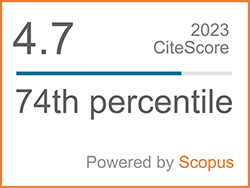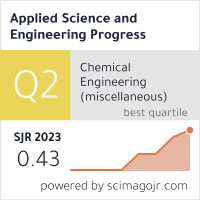Impact of Yeast Strain Selection on Ethanol Yield from Low Concentration KMnO4 Pretreated Rice Straw: Process Design and Utility Cost Analysis
Abstract
Keywords
[1] A. Satlewal, R. Agrawal, S. Bhagia, P. Das, and A. J. Ragauskas, “Rice straw as a feedstock for biofuels: Availability, recalcitrance, and chemical properties,” Biofuels, Bioproducts and Biorefining, vol. 12, pp. 83–107, Oct. 2017, doi: 10.1002/bbb.1818.
[2] N. Vivek, L. M. Nair, B. Mohan, S. C. Nair, R. Sindhu, A. Pandey, N. Shurpali, and P. Binod, “Bio-butanol production from rice straw–recent trends, possibilities, and challenges,” Bioresource Technology Reports, vol. 7, May 2019, Art. no. 100224, doi: 10.1016/j.biteb.2019. 100224.
[3] A. Alengebawy, Y. Ran, N. Ghimire, A. I. Osman, and P. Ai, “Rice straw for energy and value-added products in China: A review,” Environmental Chemistry Letters, vol. 21, pp. 2729–2760, Jun. 2023, doi: 10.1007/s10311-023-01612-3.
[4] A. Devi, A. Singh, S. Bajar, D. Pant, and Z.U. Din, “Ethanol from lignocellulosic biomass: An in-depth analysis of pre-treatment methods, fermentation approaches and detoxification processes,” Journal of Environmental Chemical Engineering, vol. 9, Oct. 2021, Art. no. 105798, doi: 10.1016/j.jece.2021.105798.
[5] T. Raj, K. Chandrasekhar, A. N. Kumar, J. R. Banu, J. J. Yoon, S. K. Bhatia, Y. H. Yang, S. Kim, and S. H. Varjani, “Recent advances in commercial biorefineries for lignocellulosic ethanol production: Current status, challenges and future perspectives,” Bioresource Technology, vol. 344, Jan. 2022, Art. no. 126292, doi: 10.1016/j.biortech.2021.126292.
[6] C. Hatzis, C. Riley, and G. Philippidis, “Detailed material balance and ethanol yield calculations for the biomass-to-ethanol conversion process,” in Seventeenth Symposium on Biotechnology for Fuels and Chemicals, vol. 57, C. E. Wyman and B. H. Davison, Eds. Totowa, NJ: Humana Press, pp. 443–459, Jan. 1996, doi: 10.1007/978-1-4612-0223-3_41.
[7] R. Ningthoujam, P. Jangid, V. K. Yadav, D. K. Sahoo, A. Patel, and H. K. Dhingra “Bioethanol production from alkali-pretreated rice straw: Effects on fermentation yield, structural characterization, and ethanol analysis,” Frontiers in Bioengineering and Biotechnology, vol. 11, Aug. 2023, Art. no. 1243856, doi: 10.3389/fbioe.2023.1243856.
[8] C. Lee, Y. Zheng, and J. S. V. Gheynst “Effects of pretreatment conditions and post–pretreatment washing on ethanol production from dilute acid pretreated rice straw,” Biosystems Engineering, vol. 137, pp. 36–42, Sep. 2015, doi: 10.1016/j.biosystemseng.2015. 07.001.
[9] M. Mohammadi, M. Shafiei, A. Abdolmaleki, K. Karimi, J. P. Mikkola, and C. Larsson “A morpholinium ionic liquid for rice straw pretreatment to enhance ethanol production,” Industrial Crops and Products, vol. 139, Nov. 2019, Art. no. 111494, doi: 10.1016/j.indcrop. 2019.111494.
[10] P. Mutrakulcharoen, P. Pornwongthong, S. A. Sahithi, T. Phusantisampan, A. Tawai, and M. Sriariyanun “Improvement of potassium permanganate pretreatment by enzymatic saccharification of rice straw for production of biofuels,” in E3S Web of Conferences, Sep. 2021, vol. 302, Art. no. 02013, doi: 10.1051/ e3sconf/202130202013.
[11] S. Prasad, S. Kumar, K. K. Yadav, J. Choudhry, H. Kamyab, Q. V. Bach, K. R. Sheetal, S. Kannojiya, and N. Gupta “Screening and evaluation of cellulytic fungal strains for saccharification and bioethanol production from rice residue,” Energy, vol. 190, Jan. 2020, Art. no. 116422, doi: 10.1016/j.energy.2019.116422.
[12] T. Tadesse, D. Dase, A. D. Koricha, and K. Bacha, “Optimization of bioethanol production using response surface methodology for stress‐tolerant wild yeasts isolated from natural forests,” International Journal of Energy Research, vol. 2024, Jun. 2024, Art. no. 7086047, doi: 10.1155/2024/7086047.
[13] S. Kirdponpattara, S. Chuetor, M. Sriariyanun, and M. Phisalaphong, “Bioethanol production by Pichia Stipitis immobilized on water hyacinth and thin-shell silk cocoon,” Applied Science and Engineering Progress, vol. 15, 2022, Art. no. 4662, doi: 10.14416/j.asep.2021.03.006.
[14] M. A. Khan, E. J. Panakkal, M. Sriariyanun, M.P. Gundupalli, S. Roddecha, K. Katam, J. Jayaprakash, and K. Cheenkachorn, “Dewaxing and post-pretreatment washing: impact on sugar and ethanol yields from tobacco residue,” Applied Science and Engineering Progress, vol. 17, no. 4, 2024, Art. no. 7495, doi: 10.14416/ j.asep.2024.07.010.
[15] S. Sharma, M. R. Swain, A. Mishra, A. S. Mathur, R. P. Gupta, S. K. Puri, and A. K. Sharma “High solid loading and multiple-fed simultaneous saccharification and co-fermentation (mf-SSCF) of rice straw for high titer ethanol production at low cost,” Renewable Energy, vol. 179, pp. 1915–1924, Dec. 2021, doi: 10.1016/j.renene.2021.07.146.
[16] P. Nandal, S. Sharma, and A. Arora “A Bioprospecting non-conventional yeasts for ethanol production from rice straw hydrolysate and their inhibitor tolerance,” Renewable Energy, vol. 147, pp. 1694–1703, Mar. 2020, doi: 10.1016/j.renene.2019.09.067.
[17] N. Kumar, A. Yadav, G. Singh, A. Singh, P. Kumar, and N. K. Aggarwal “Comparative study of ethanol production from sodium hydroxide pretreated rice straw residue using Saccharomyces cerevisiae and Zymomonas mobilis,” Archives of Microbiology, vol. 205, p. 146, Mar. 2023, doi: 10.1007/s00203-023-03468-1.
[18] M. S. Abdel-Salam, S. S. Hafez, M. Fadel, S. A. Mohamed, W. K. Hegazy, and B. E. Khalil, “Bio ethanol production from rice straw saccharification via Avicelase gene in E. coli recombinant strain,” Clean Technologies, vol. 5, pp. 451–465, Apr. 2023, doi: 10.3390/ cleantechnol5020023.
[19] P. Ranganathan “Preliminary techno-economic evaluation of 2G ethanol production with co-products from rice straw,” Biomass Conversion and Biorefinery, vol. 12, pp. 3673–3686, Nov. 2020, doi: 10.1007/s13399-020-01144-8.
[20] M. Botshekan, A. Moheb, F. Vatankhah, K. Karimi, and M. Shafiei, “Energy saving alternatives for renewable ethanol production with the focus on separation/purification units: A techno-economic analysis,” Energy, vol. 239, Jan. 2022, Art. no. 122363, doi: 10.1016/ j.energy.2021.122363.
[21] M. P. Gundupalli, K. Cheenkachorn, S. Chuetor, S. Kirdponpattara, S. P. Gundupalli, P. L. Show, and M. Sriariyanun, “Assessment of pure, mixed and diluted deep eutectic solvents on Napier grass (Cenchrus purpureus): Compositional and characterization studies of cellulose, hemicellulose and lignin,” Carbohydrate Polymers, vol. 306, Apr. 2023, Art. no. 120599, doi: 10.1016/j.carbpol.2023.120599.
[22] C. Areepak, T. Jiradechakorn, S. Chuetor, C. Phalakornkule, M. Sriariyanun, M. Raita, V. Champreda, and N. Laosiripojana “Improvement of lignocellulosic pretreatment efficiency by combined chemo-Mechanical pretreatment for energy consumption reduction and biofuel production,” Renewable Energy, vol. 182, pp. 1094–1102, Jan. 2022, doi: 10.1016/j.renene. 2021.11.002.
[23] E. J. Panakkal, K. Cheenkachorn, S. Chuetor, P. Tantayotai, N. Raina, Y. S. Cheng, and M. Sriariyanun, “Optimization of deep eutectic solvent pretreatment for bioethanol production from Napier grass,” Sustainable Energy Technologies and Assessments, vol. 54, Dec. 2022, Art. no. 102856, doi: 10.1016/j.seta.2022. 102856.
[24] E. J. Panakkal, M. Sriariyanun, J. Ratanapoompinyo, P. Yasurin, K. Cheenkachorn, and W. Rodiahwati, and P. Tantayotai, “Influence of sulfuric acid pretreatment and inhibitor of sugarcane bagasse on the production of fermentable sugar and ethanol,” Applied Science and Engineering Progress, vol. 15, no. 1, 2022, Art. no. 5238, doi: 10.14416/j.asep.2021.07.006.
[25] S. Chuetor, E. J. Panakkal, T. Ruensodsai, K. Cheenkachorn, S. Kirdponpattara, Y. S. Cheng, and M. Sriariyanun, “Improvement of enzymatic saccharification and ethanol production from rice straw using recycled ionic liquid: The effect of anti-solvent mixture,” Bioengineering, vol. 9, p. 115, Mar. 2022, doi: 10.3390/bioengineering 9030115.
[26] C. Hatzis, C. Riley, and G. Philippidis, “Detailed material balance and ethanol yield calculations for the biomass-to-ethanol conversion process,” in Seventeenth Symposium on Biotechnology for Fuels and Chemicals, vol. 57, C. E. Wyman and B. H. Davison, Eds. Totowa, NJ: Humana Press, pp. 443–459, Jan. 1996, doi: 10.1007/978-1-4612-0223-3_41.
[27] D. Humbird, R. Davis, L. Tao, C. Kinchin, D. Hsu, A. Aden, P. Schoen, B. Lukas, M. Olthof, D. Worley, D. Sexton, and D. Dudgeon, “Process design and economics for biochemical conversion of lignocellulosic biomass to ethanol: Dilute-acid pretreatment and enzymatic hydrolysis of corn stover,” National Renewable Energy Laboratory, Colorado, United States, Rep. NREL/TP-5100-47764, May 2011.
[28] G. D. Ulrich and P. T. Vasudevan, “How to estimate utility costs,” Chemical Engineering, vol. 113, pp. 66–69, Apr. 2016.
[29] C. S. Tucker and C. E. Boyd, “Relationships between potassium permanganate treatment and water quality,” Transactions of the American Fisheries Society, vol. 106, pp. 481–488, Jan. 2011, doi: 10.1577/1548-8659(1977)106<481: RBPPTA>2.0.CO;2.
[30] Y. Wang, K. Zheng, H. Guo, L. Tian, Y. He, X. Wang, and Y. Liu, “Potassium permanganate-based advanced oxidation processes for wastewater decontamination and sludge treatment: A review,” Chemical Engineering Journal, vol. 452, Jan. 2023, Art. no. 139529, doi: 10.1016/j.cej.2022.139529.
[31] S. Amornraksa, C. Panjapornpon, S. K. Maity, M. Sriariyanun, and A. Tawai, “AOPC-based control for efficient uncertainty mitigation in UASB wastewater treatment with multiple manipulated variables and distributed biomass integration,” Computers & Chemical Engineering, vol. 187, Aug. 2024, Art. no. 108735, doi: 10.1016/j.compchemeng.2024.108735.
[32] V. L. Nieto-Sarabia, C. B. Ballinas-Cesatti, G. Melgar-Lalanne, E. Cristiani-Urbina, and L. Morales-Barrera “Isolation, identification, and kinetic and thermodynamic characterization of a Pichia kudriavzevii yeast strain capable of fermentation,” Food and Bioproducts Processing, vol. 131, pp. 109–124, Jan. 2022, doi: 10.1016/j.fbp.2021.10.013.
[33] N. W. Burman, C. M. Sheridan, and K. G. Harding “Feasibility assessment of the production of bioethanol from lignocellulosic biomass pretreated with acid mine drainage (AMD),” Renewable Energy, vol. 157, pp. 1148–1155, Sep. 2020, doi: 10.1016/j.renene.2020. 05.086.DOI: 10.14416/j.asep.2025.05.005
Refbacks
- There are currently no refbacks.









